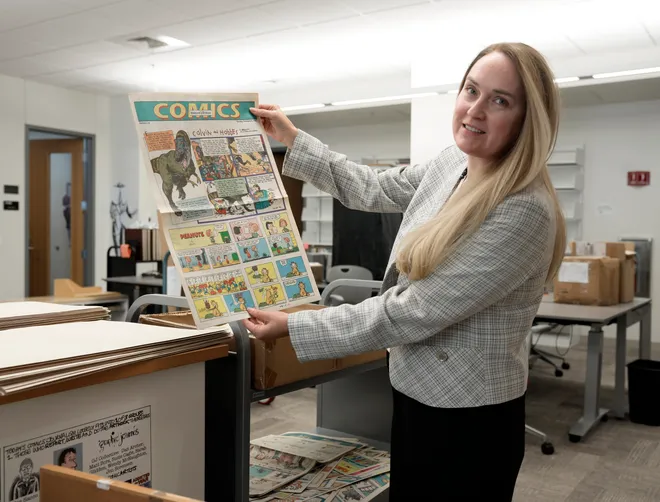“In the first half of the 19th century, newspapers had been around for centuries but had very few images because images had to be engraved or etched. By the second half of the century, they were becoming more visual.”
Columbus Dispatch reporter Belinda M. Paschal with major assistance from Jenny Robb, head curator of the Billy Ireland Cartoon Library & Museum, and Jared Gardner, the Joseph V. Denney Designated Professor of English and director of popular culture studies at OSU, presents a brief (actually rather lengthy for a newspaper article) and very good outline of the history of American newspaper comic strips for a front page feature intended for and published in many Gannett/USA TODAY Network newspapers today.

The feature article can be read at The Coloradoan, some excerpts below:
Joseph Pulitzer’s sensationalistic New York World was one of the first newspapers to publish comic strips, beginning around 1890. Many noteworthy comic strips were born in the World, including Ohio-born Richard F. Outcault’s “Hogan’s Alley,” considered the first commercially successful newspaper comic strip.
“Suddenly, there are newspaper syndicates — the Hearst Syndicate, the King (Features) Syndicate. Comics could be published across the country and every day on the same day, everybody would read the same comics. This became, really, the first national water cooler talk!”
… Still, the world of mainstream comics remained largely white. As the fight for racial equality intensified, Black cartoonist Morrie Turner began questioning the lack of people of color in the comics. His friend and mentor, Peanuts creator Charles M. Schulz told him, “You should do a strip,” according to Robb.
In the early 20th century, the comic strip “Lucy and Sophie Say Goodbye” walked so contemporary artists like Alison Bechdel and Lynn Johnston could run … Lucy and Sophie’s farewells, which always held up urgent business bustling around them, initially included a kiss obscured by their Belle Époque-style hats. But as the strip continued, their kisses and embraces became less ambiguous and decidedly more passionate.
Other strips have been the target of ire, most notably Garry Trudeau’s “Doonesbury,” which has been withheld or given the boot altogether a handful of times in its 50-plus years of existence. “When (Trudeau) declared the Watergate conspirators to be ‘guilty, guilty, guilty,’ a lot of papers were upset,”
“In the last 20 years, we’ve been seeing many artists move entirely to digital art. There’s no originals; it’s all bits and bytes,” she said.
As seen by the above brief quotes the newspaper feature admirably covers the entire history of newspaper comic strips and panels. A recommended read before moving on to the various comic history books by Brian Walker, Ron Goulart, Maurice Horn, and others.
feature photo by Barbara J. Perenic/The Columbus Dispatch

How ironic that Gannett runs an article on the history of comics immediately after reducing and standardizing the number of comics that appear in their newspapers.
It is also not true that all modern comics are created entirely with pixels. Some of us still work on paper. The declining number of newspapers and of ‘approved’ comics means that we may always appear in digital format, never in newsprint.
I have given much thought to syndicated comics. For DECADES syndicates fostered the idea that “only a select few can be syndicated cartoonists”. Some folks tried and tried to get accepted ; to prove their “worth” in the hop e that a syndicate would try to market their creation and take HALF. The scramble for money grew and newspaper comic pages became crowded but things changed – the internet was developed and newspapers began to dwindle.
Then folks began putting their strips online! Strips that may never have been accepted by syndicates, could find their own audience and flourish, and if there was money to be made – the creator kept it all!
As newspapers continue to die, syndicates are happy to point to their portals but there are numerous portals online.
This article here seems a tad bittersweet – Gannett saying “look, we have along, celebrated history with comics” as they dump on comics, while trying to save their papers.
Times are changing … in favor of cartoonists … online.